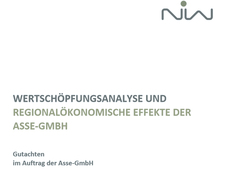The Asse environment project as economic factor: Over 1,700 jobs across Germany
BfS and Asse-GmbH present results from economic study
Date 2016.01.28
In 2014, the expenses for the decommissioning of the Asse mine ensured over 1700 jobs across Germany. This number is based on a current economic study presented today by Wolfram König, President of the Federal Office for Radiation Protection, and Hans-Albert Lennarth, Commercial Director of the Asse-GmbH. The 1,700 jobs comprise both persons working directly at Asse-GmbH and jobs that are required to manage all services and goods required in the environment project.
"Regarding public spending for the decommissioning of the Asse mine, the safety of the people in the region is justly the highest priority. In parallel, new options and perspectives are created in a structurally weak area,"
says König. As representative of the shareholder he had asked the Asse-GmbH to examine as to how the spending would affect the economic situation. The study was conducted by the Lower Saxon Institute for Economic Research (NIW).
Increasing number of persons employed provides positive economic effects
With an increasing number of tasks, also the spending for the Asse project has nearly doubled, from about 63 million euros in 2009 to about 117 million euros in 2015. Thus, also the number of persons immediately employed by the Asse-GmbH increased from 251 in 2009 to 460 now. “Most of our employees, about two thirds, also live in the examined area and generate further positive economic effects through consumer spending,” says Hans-Albert Lennartz. The region examined comprises the rural districts of Wolfenbüttel, Peine, Gifhorn, Helmstedt and Goslar. The experts evaluate that the spending of the employees and services and goods required by the Asse-GmbH financed between 540 and 570 jobs here in 2014 alone.
"In view of future large projects, there will still be an increasing need for employees and special technical requirements,"
Wolfram König adds and particularly points out the construction of the planned recovery shaft. This will increase the economic attraction. In addition there are three million euros annually, paid by the federal government to the Asse Future Fund for regional assistance. The foundation was established in 2015. "That the Parliament approves millions of euros for the long term should not be taken for granted,"
König said. However, spending is more often granted if it is not considered a burden but also an investment.


